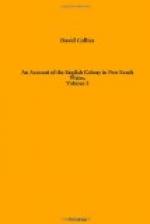With respect to fertility, the general aspect only can be spoken of. About the head of the bay, the trees were of a fair growth; grass seemed sufficiently abundant, and there were few appearances of sand. Some parts of it Mr. Flinders thought were stony.
Of the inhabitants he could only observe, that their smokes were numerous about the bay, and that they at times frequented Curlew islet.
Of the animal, vegetable, or fossil productions of the bay, he could not speak, the shortness of his stay not permitting any examination.
From the appearance of the tide the day that he landed upon the islet, it had been high water between twelve and one o’clock, which was between three and four hours before the moon came upon the meridian.
The mean of nine amplitudes taken in this bay gave the variation 9 degrees 44 minutes east; and of two sets of azimuths 9 degrees 15 minutes east; from both, the mean variation of the azimuth compass was 9 degrees 30 minutes east.
Having cleared the point of Break Sea Spit, on Thursday the 8th he proceeded on his return to Port Jackson. Passing the land between Smoky Cape and the Solitary Isles in the day which had been before passed in the night, he observed that it seemed to be higher than most parts of its coast in the neighbourhood, Mount Warning excepted; and even there it was not so high near the shore. The view that he had of the land at sunset, when Smoky Cape bore S 25 degrees W distant five or six leagues, induced Mr. Flinders to think it probable that there might be an opening to the northward of it.
In the afternoon of Sunday the 18th, there being but little wind, and the weather fine, they were attended by several very large spermaced whales. They were not more than twice the sloop’s length from her, coming up on either side at times very near her; and remained playing, or perhaps feeding, in this way for more than two hours.
Their appearance was followed in the evening by a gale from the SW which reduced them to their storm sails, and compelled them to keep off and on during the night. The wind, however, moderating the next day, and a southerly current having been in their favour, Mr. Flinders concluded his labours at dusk in the evening of the 20th; at which time he secured his little vessel alongside his Majesty’s ship the Reliance in Port Jackson.




